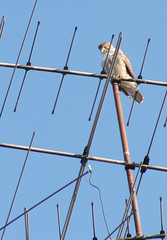It's been almost a month since I
started Richard Dawkins's
The Ancestor's Tale: A Pilgrimage to the Dawn of Life. It's a pretty hefty book, and I got interrupted a few times.
It's hefty, but it's fascinating. There was a lot of good material I hadn't seen before, or only new about vaguely, and the novel presentation put an interesting perspective on everything.
As I mentioned in my preview post, the book is told as a backwards trip through the evolutionary tree, starting with modern humans, with a chapter at each of the branching points between our history and that of any still-surviving cousins we have. Dawkins calls these branching points "rendezvous" (since we're going backwards) and refers to the last common ancestor between the two branches as the "concestor" for that rendezvous. For example, Rendezvous 17 is with the amphibians, and concestor 17 would be the last animal who had some descendants who went on to become modern amphibians and other descendants who went on to become humans. Naturally -- and this is an important point Dawkins repeats often for the various concestors -- concestor 17 was not an modern amphibian itself! That may seem obvious, but when Larry King asks questions like "If evolution is true, why are there still monkeys?" on his show, it's a point that's obviously lost on many people.
Each Rendezvous has its own chapter, and most of those consist of one or more tales of modern animals from the other branch. For example, Rendezvous 26 -- Protosomes -- is where the our branch and the one that would give rise to insects, crustaceans, spiders, worms, and so on, join. That chapter includes The Ragworm's Tale, The Brine Shrimp's Tale, The Fruit Fly's Tale, etc.
What wasn't clear when I wrote my preview post, though, was that the animals in these tales are actually excuses to tell much more varied tales than just histories of various evolutionary paths. Rather, Dawkins uses them to explore evolutionary concepts exemplified by the subject species. The Fruit Fly's Tale deals primarily with Hox genes (whose function were first determined through experiments on fruit flies). Hox genes are responsible for turning other genes on and off within a cell based on a cell's position within a body: they're what make arms become arms and legs become legs (among other things). Mutations in Hox genes in fruit flies can turn antennae into legs or give the fly extra wings.
Similarly, The Platypus's Tale is about electro-sensitivity (platypuses can detect electrical fields with their bill), The Redwood Tale is about dating methods (starting with dendrochronology, taking by patterns of tree rings), The Salamander's Tale is about ring species and racial distinctions, and so on.
There are also two summary chapters at the end, Cantebury and The Host Returns. Cantebury represents the start of it all, the root of the tree from which all these Rendezvous descend, and Dawkins uses it to talk about important first step in evolution. Not so much the origin of life, but the origin of heredity -- without heredity, you can't have evolution. He discusses a fascinating experiment I hadn't ever heard of, done using a RNA virus called Qβ.
Qβ, like any virus, is a genetic parasite which hijacks a cell's DNA/RNA transcription systems to make copies of itself and the proteins that it uses (one to enclose the RNA, one to stick the virus to the cell, one to destroy the cell to let the copies free, and one that assembles the Qβ copying protein, Qβ replicase, out of proteins found in the cell).
The experiment consisted of putting Qβ RNA and Qβ replicase in test tubes away from any cells to see what happened. Before long, even without the cell's full-fledge copying system on hand, the Qβ was being copied. Not only that, but as the experiment was iterated through successive "generations" (samples from one experiment moved to a fresh test tube), the Qβ RNA changed, loosing the genes that encoded the shell, glue, or escape proteins, since they weren't needed in the test tube environment. The Qβ RNA was reduced from 3600 codons to only 550. In some experiments, the Qβ RNA wasn't even necessary: the experimenter simply mixed raw material for making RNA with Qβ replicase, and soon a very Qβ-like RNA virus appeared.
Dawkins found this interesting because it demonstrated that you could have an evolving system with heredity with only RNA (or RNA components) and a single protein. I found it interesting because it reminded me of
Tierra and
Avida, experiments in genetic programming. Tierra lets you write short, self-replicating computer programs and then runs them in an environment where they are subject to selection pressures and mutation. Avida is based on Tierra.
One of the early results from Tierra (or maybe Avida, I can't remember which one this actually happened on -- maybe both) was a program which, through evolution in the system, shortened itself substantially, making itself more successful by reducing the amount of steps it took to copy itself. In fact, the code was tightened so much that it was hard for the developers watching it to figure out how it worked -- it was more optimized than any human author would think they could make it.
This being Dawkins, there are some interesting sociology-of-science bits as well. Naturally, he discusses the shortcomings of creationism in addressing the results biologists have been getting in their research, and throws in a couple of light barbs at creationists' tendencies to
quote biologists selectively. Though the thing he harps on most of all is how the rules of biological nomenclature have stuck us with a number of rather inappropriate names for species, processes, and theories. Unfortunately, I didn't think to make notes of examples, and they're rather hard to find by flipping through the book.
My only real complaint about
The Ancestor's Tale is Dawkins's writing style. His tone tends to wobble between lectorial and conversational, rather than going for one or the other -- or striking a balance somewhere in between. It's not at all a major problem, but it did make the book's flow a little uneven in places. Still, he got to marry
Romana after being introduced to her by
Douglas Adams. I suppose it'd be too much to expect him to write like
Isaac Asimov on top of all that.
Read more!
 All of this is completely irrelevant to Toronto hawks, except to explain why I'm not posting about them and not books. The hawks -- well, one hawk -- came in this afternoon on our way back from groceries. We noticed a couple of flocks of synchronized pigeons circling over the street. We found that a little odd, as Toronto pigeons are not known for exerting themselves, until we noticed why they were flapping around: they were chasing a hawk, who fled the pigeon-infested area and settled down on a TV aerial on a nearby building.
All of this is completely irrelevant to Toronto hawks, except to explain why I'm not posting about them and not books. The hawks -- well, one hawk -- came in this afternoon on our way back from groceries. We noticed a couple of flocks of synchronized pigeons circling over the street. We found that a little odd, as Toronto pigeons are not known for exerting themselves, until we noticed why they were flapping around: they were chasing a hawk, who fled the pigeon-infested area and settled down on a TV aerial on a nearby building.
